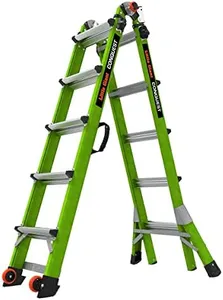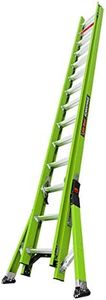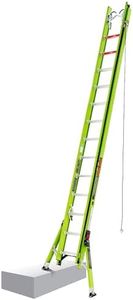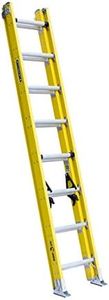10 Best Extension Ladders 2025 in the United States
Our technology thoroughly searches through the online shopping world, reviewing hundreds of sites. We then process and analyze this information, updating in real-time to bring you the latest top-rated products. This way, you always get the best and most current options available.

Our Top Picks
Winner
Little Giant Ladders Systems Conquest 2.0, M22, 22ft, Multi-Position Ladder, Fiberglass, Type 1A, 300 lbs Weight Rating, (17122-001), Green
Most important from
21 reviews
The Little Giant Ladders Systems Conquest 2.0 is a versatile multi-position ladder that stands out for its ability to adapt to various configurations, such as stepladder, extension, and even for use on staircases. This flexibility makes it a great choice for homeowners and DIY enthusiasts who need a reliable ladder for different tasks around the house. The ladder is made of lightweight, non-conductive fiberglass, making it both durable and safe to use, especially in electrical environments, which is a significant advantage. With a weight rating of 300 lbs, it accommodates most users and gear comfortably.
One of the notable features is its wide-flared legs which provide added stability, an essential factor when working at heights. The built-in Tip & Glide Wheels and a weight-balanced carrying handle make it relatively easy to transport, which is important for anyone who may need to move the ladder frequently.
The ladder does weigh 42 pounds, which may feel heavy for some users, especially when carrying it for longer distances. While the ladder's design allows for access to tight spaces, it may not reach the heights required for very tall tasks, as its maximum extension is 22 feet. The Little Giant Conquest 2.0 is a solid choice for those seeking a reliable and flexible extension ladder for home use or light professional tasks. While its weight and height may be limiting factors for some, its safety features and versatile configurations make it a strong contender in the ladder market.
Most important from
21 reviews
Louisville Ladder FE3216 Foot Extension Ladder, 16 ft, Orange
Most important from
395 reviews
The Louisville Ladder FE3216 Foot Extension Ladder stands at 16 feet, making it suitable for both household and professional use. Its fiberglass construction ensures non-conductive safety, which is essential for electrical work. The ladder’s weight capacity is impressive, supporting up to 300 pounds, making it sturdy for various users and heavy-duty tasks.
The MaxLock Rung Lock and QuickLatch system enhance user safety and ease of use by securely locking the ladder in place during extension. Stability is further ensured with steel swivel safety shoes that adapt to uneven surfaces, providing additional safety margins.
At 30 pounds, the ladder is relatively lightweight for its size, enhancing portability, although it might still be a bit cumbersome for some users to carry alone. Potential buyers should consider if the 30-pound weight is manageable for their individual needs. Additionally, its large size may pose storage challenges for some. The Louisville Ladder FE3216 is a solid choice for those needing a durable, safe, and high-capacity ladder.
Most important from
395 reviews
Louisville Ladder 24-foot Aluminium Extension Ladder, 300-Pound Load Capacity, Type IA, AE2224
Most important from
448 reviews
The Louisville Ladder 24-foot Aluminium Extension Ladder is designed to cater to both professionals and DIY enthusiasts who need a reliable and sturdy ladder for high-reaching tasks. One of its standout features is the lightweight aluminum construction, which balances portability and strength, making it easier to transport and maneuver. With a 300-pound load capacity, it is robust enough for a variety of uses while still offering safety, as it meets and exceeds ANSI and OSHA standards.
The ladder's Quicklatch system is a practical addition, ensuring that the sections are securely locked during use, enhancing safety. The inclusion of a steel swivel safety shoe helps maintain stability on uneven surfaces, which is a significant advantage for users working on less-than-perfect ground.
This extension ladder is an excellent choice for users looking for a balance of portability, safety, and durability, making it suitable for a wide range of tasks. Potential buyers should consider their specific needs and experience level to ensure it aligns with their expectations.
Most important from
448 reviews
Buying Guide for the Best Extension Ladders
Choosing the right extension ladder is crucial for safety and efficiency when working at heights. The right ladder will depend on the type of tasks you need to perform, the height you need to reach, and the environment in which you'll be using it. Here are some key specifications to consider when selecting an extension ladder, along with explanations to help you make an informed decision.FAQ
Most Popular Categories Right Now













